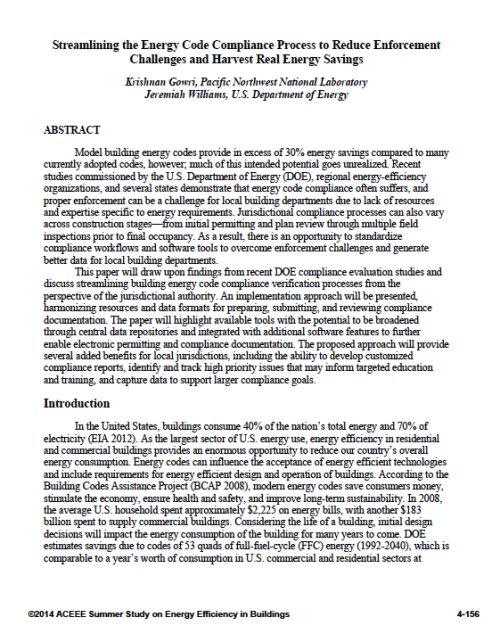
Talking Points
The simple adherence to energy codes may sound like a modest goal. The construction of new homes, after all, is already guided by energy codes that specify, among other things, what types of energy systems should be installed and how they should perform.
Yet the simple goal of following energy codes has fallen far short in actual practice, with energy-code compliance in the U.S. varying from 10 to 80 percent of the stated requirements. This shortfall has been well documented in both research literature and anecdotal experience, and correcting it has been the object of many well-funded programs. Yet the numbers have not budged appreciably for years, and in some areas the level of non-compliance has created an anything-goes attitude within industry. In this business environment, builders and trade allies that adhere to energy codes and provide high-performance buildings are at a distinct competitive disadvantage.
Homeowners, on the other hand, have remained unaware of this problem, with most presuming that their homes are built “according to code”, and that their purchase is protected by layers of governmental oversight. This is clearly not the case, with many homeowners incurring unexpected expenses totaling tens of thousands of dollars for excessive utility bills, high maintenance costs, potential health risks, and myriad other “non-energy detriments” that are associated with these sub-standard but built-to-code homes. There is a compelling case here for a defense of consumer rights that could be achieved by widespread adherence to the energy codes that have already been adopted by every U.S state.
Resource. The Compliance Project Newsletters
Resource. Slide deck for the Compliance Project
This slide deck provides a brief overview the background, mission, and work plan for the project. View or download the 1.3 MB PDF file.
Resource. The Recovery Act is Back. Can It Deliver High Performance Homes?
This short article, written by Ryan Boswell, outlines the agreement made by the states, in accepting ARRA funding, to achieve at least 90% compliance with IECC 2009 by the year 2017. A surprising number of states won’t make it, but there may be some opportunity here for organizations that deliver services in the laggard states.
View or download the PDF file.
Resource. DOE Residential Energy Code Field Study
The U.S. Department of Energy is in the process of studying code compliance around the country. The Residential Energy Code Field Study is in year 1 of 4 years, and they’ve recently released some early findings. It’s not a perfect study — among other limitations is the fact that it’s being conducted only in 6 Southeastern and Eastern states, so there are few samples from zone 5, and nothing from 6, 7, or 8. But there’s a lot of data here that’s relevant to our project, plus a few surprise findings.
View or download the 1.8 MB PDF slide deck.
Resource. Streamlining the Energy Code Compliance Process
This is a short and relevant little primer, produced by Krishnan Gowri and Jeremiah Williams of the Pacific Northwest National Laboratory.
View or download the 900 KB PDF document.
Resource: the website for the International Energy Conservation Code
The US housing industry operates under a mix of energy codes that generally include the IECC for 2009, 2012, and 2015. It’s dry reading to wade through these codes, but it’s a necessary piece of research if you need to understand the details of code compliance.







